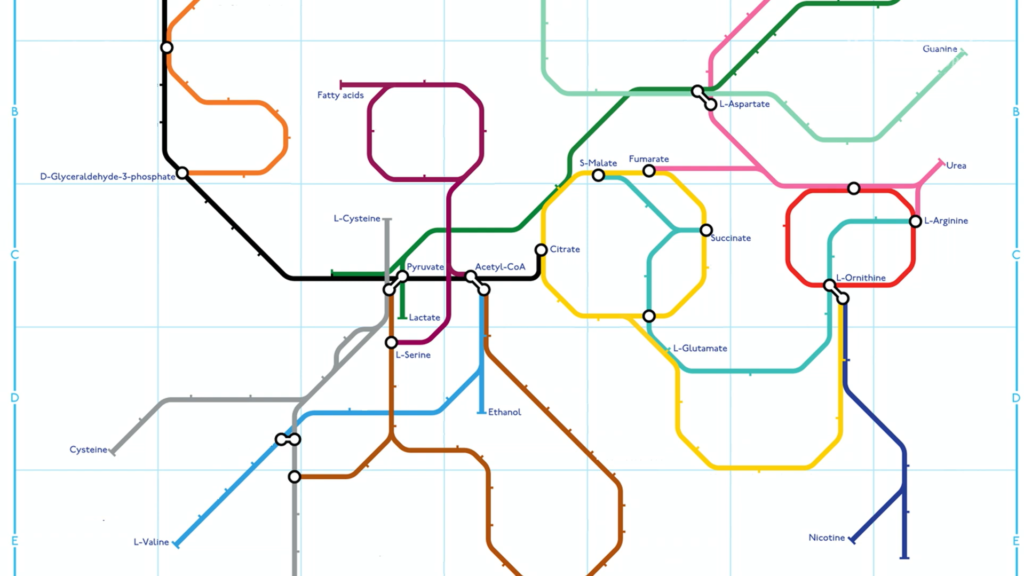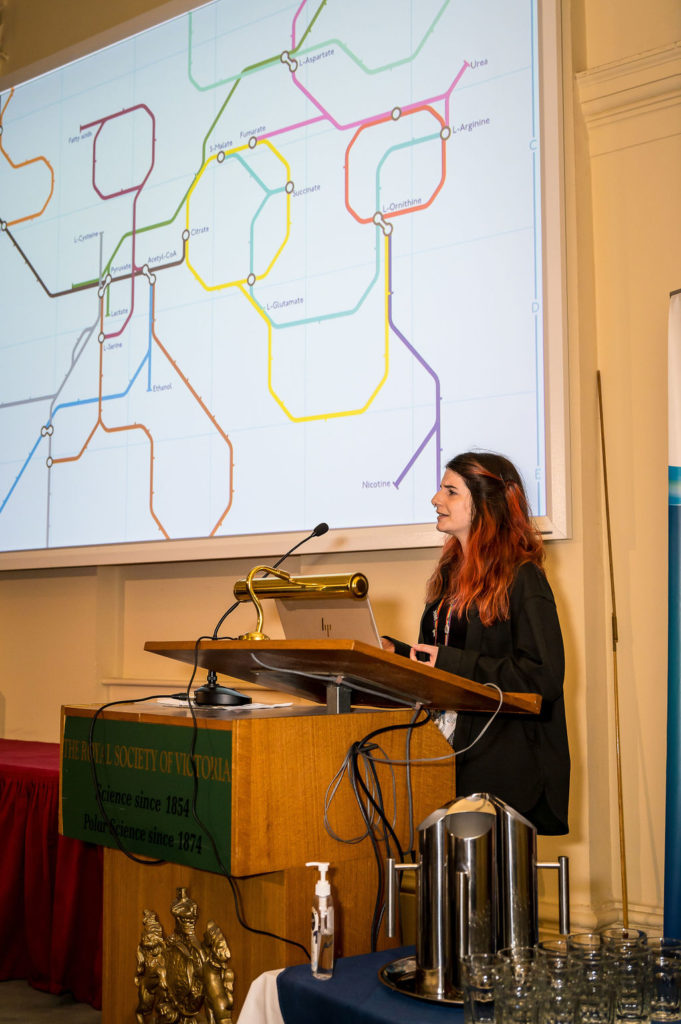Getting Back on Track
The Royal Society of Victoria annually awards four competitive prizes to final year PhD students in all areas of the Biomedical & Health Sciences, Biological Sciences (Non-human), Earth Sciences, and Physical Sciences. In September 2023, we heard from this year’s eight finalists about their brilliant work in these fields. Over the coming months, they will share a written summary of their presentations in Science Victoria.
For more information about the RSV’s Young Scientist Research Prize, visit rsv.org.au/young-scientist-research-prizes
—
Getting Back on Track
By Sarah Mele MRSV
2023 RSV Young Scientist Research Prizes (Biological Sciences) – 1st place winner
Metabolism – it’s how the food we eat gets turned into energy, and surprisingly it’s a lot like a train network.
Your metabolism is a series of interconnected chemical reactions that have a beginning and a destination. At each “stop”, a reaction is carried out by an enzyme, the chemical catalysts of the body, to allow the process to keep moving along the path.
But much like a train network, it doesn’t always run.
The amino acid train line
Amino acids are the building blocks of proteins. Every time you eat protein, it is broken down into amino acids which then embark on their journey to be mixed and matched, and rebuilt as different proteins.

But what if there’s an obstruction on the track — a malfunctioning enzyme? That can lead to an amino acid disorder. Not only is there a dangerous pile-up behind the obstruction, but there’s also a deficit at the end of the track.
My project is focused on one small track of the network to do with an amino acid called valine. The metabolism of valine involves at least seven stages and a deficiency of the appropriate enzyme at any of these stages means that the train comes to a halt, leading to a disorder of varying severity and rarity. The resulting disease makes it hard for infants to learn to walk and talk.
There are ways we can try to fix this by changing their diet:
- Restrict: By limiting the number of amino acids that are coming down the line to avoid congestion on the train line, in this case, valine.
- Resupply: By starting new trains after the obstruction.
- Reroute: By diverting trains down an alternate track that might not get you to your original destination – but at least you’re not stranded.
Together these changes help to address the underlying problem.
Patients with amino acid disorders usually have to restrict protein in their diet and replace it with medical food substitutes. This can be constraining, but life-saving. Despite this, many amino acid disorders lack treatments because they are very rare, occurring in roughly 1 in 6500 births, making them difficult to study.1

One of the disorders I studied in my PhD is HIBCH (3-hydroxyisobutyryl-CoA deacylase) deficiency. It is currently not fully understood whether changes in diet can effectively treat this disorder. I therefore tested some treatments on a model organism: the fruit fly, Drosophila (these flies share 70% of disease-causing genes with humans, who knew!?).2 Flies with HIBCH deficiency don’t move or develop as well as their healthy counterparts.
First, I tried to restrict – I reduced valine in the diet and saw that flies were not much better off. Second, I tried to resupply – I added a compound to the diet that valine is normally broken down into if HIBCH enzymes were functioning as normal. This didn’t help much either. Third, I tried to reroute – a compound called carnitine can combine with one of the molecules that builds up with this disorder, altering it and allowing it to be transported elsewhere or excreted. I added carnitine to the diet and saw that more of the flies with the disorder were able to develop, and faster too.
This is the first model organism for HIBCH deficiency and other valine metabolic disorders. Now that these model organisms have been established, they can be used for large-scale diet and drug screens to bring us closer to finding treatments for individuals with these rare metabolic disorders.
References
- Waters et al. (2018) Global birth prevalence and mortality from inborn errors of metabolism: a systematic analysis of the evidence. Journal of Global Health, 8 (2):021102. doi: 10.7189/jogh.08.021102
- Mele et al. (2023) Drosophila as a diet discovery tool for treating amino acid disorders. Trends in Endocrinology and Metabolism, 34 (2), 85-105. doi: 10.1016/j.tem.2022.12.004
Read more from the finalists of the 2023 RSV Young Scientist Research Prizes:
Gusts in the Headwind, by Dr Grace Lawrence MRSV
Looking at Clouds in the Sky is More Complex Than You Think, by Estefania Montoya Duque MRSV
Getting Back on Track, by Sarah Mele MRSV
Harnessing Immune Cells in the Bowel to Fight Cancer, by Marina Yakou MRSV
The Lighter Side of Building Bionic Eyes, by William Kwan MRSV
Where Do We Come From, and When?, by Dr Wenjing Yu MRSV
How Fire Shapes Plant Life Cycles, By Ella Plumanns Pouton MRSV






